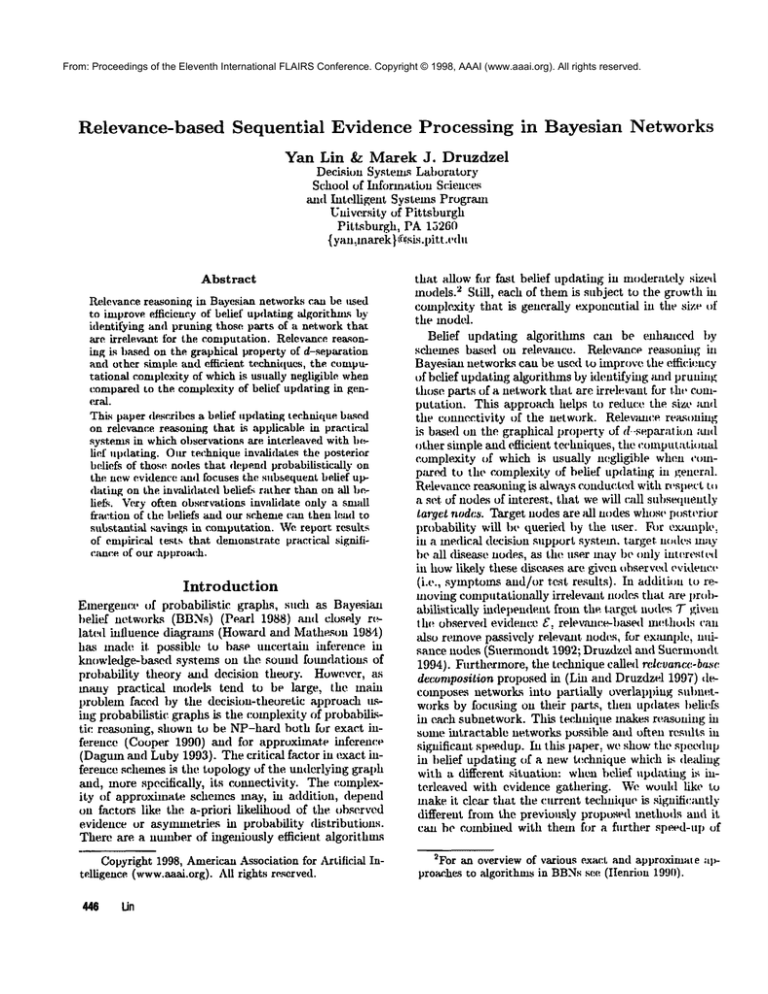
From: Proceedings of the Eleventh International FLAIRS Conference. Copyright © 1998, AAAI (www.aaai.org). All rights reserved.
Relevance-based
Sequential
Evidence Processing
in Bayesian Networks
Yan Lin & Marek J. Druzdzel
Decishm Systems Laboratory
School of Information Sciences
a~ld Intelligent Systems Progra~n
University of Pittsburgh
Pittsburgh, PA 15260
{ yan:marek} ~¢sis.pitt .edu
Abstract
1-~.levance reasoning in Bayesiannetworks can be la~ed
to improveefficiency of belief updating",dgorithaL~ by
identit~ing and pruning those parts of a networkthat
are irrelevant ibr the computation. Relevance reaqoning is based on the graphical property of d-separation
and other simple and efficient techniques, the computational complexityof which is usuaUynegligible when
comparedto the complt~xityof belief updating in general.
This paper describes a belief updating technique based
on relevance reasoning that is applicable in practiced
systems ia which observations are interleaved with belief updating. Our technique invalidates the posterior
beliefs of those nodesthat (h~pentl probabilisdcalb" oa
the newevidence ~mdfocuses the subsequent belief updating on the inv~didatedbeliefs rather than on all bcliet~. Vexyoften observations inwflidate only a small
fraction of the beliefs and our schemecan then lead to
substaatial savings in computation. Wereport rcsuks
of empirical tests that demomstratcpractical signiiicanre of our approach.
Introduction
Emergenceof probabilistic graphs, sucJl as Bayesian1
belief networks (BBNs) (Pearl 1988) mid clos~.ly
lated inlluence diagrams (Howard mid Matheson 1984)
has made it. possible to base uncertain iuference in
knowledge-based systems ou the sound foundations of
probability theory mid decision theory. However, as
many practical
modeL~ tend to be large, the main
problem faced by the decision-theoretic
approach using probabilistic graphs is the complexity of probabili.~tie reasoning, shown to be NP-hard both for exact inference (Cooper 1990) and for approximate inference
(Dagumand Luby 1993). The critical factor in exact inference schemes is the topology of the underlying graph
and, more specifically, its connectivity. The complexity of approximate schemcs may, in addition, depend
on factors like the a-priori likelihood of the observed
evidence or asymmetries hi probability distributions.
There are a number of ingeniously efficient algorithms
Copyright 1998, AmericanAssociation for Artificial Intelligence (www.aaai.org).All rights reserved.
446 tin
that allow for fast belief updating in moderately sized
models.2 Still, each of them is subject to the growth in
complexity that is generaJly exponential in the size of
the model.
Belief updating algorithms ca~t be enha~ced by
sdmmesbased on relevance. Relevazlce reasoning in
Bayesim~networks can be used to improve the etficiency
of belief updating algorithms by identi~’ing and pruning
those parts of a network that are irrelevant for the computatkm. This approach helps to reduce the size aml
the connectivity of the network. Relev~mce reasoning
is based on tile graphical prolmrty of d-separation and
~l,her simple and efficient techuklues, the computati, ual
complexity of which i.~ usually negligible when ,’ompar(<l to the complexity of belief updating in general.
Relevancereasoning is always eonduc.ted with r,’slmct t..
a set of nodes of interest, that we will call subsequently
I, aL’qet nodes. Target nodes are ~dl nod¢~whoseposterior
probability will be queried by the user. For exampk,,
in a medical decision support system, target nodes may
be all disease nodes, as the user umybe only iuteres! ed
in howlikely these dise,~es are given (,bserw~d evidence
(i.e., symptolm~and/or test results). In addition to removingcomputationally irrelevmlt nodes that are l~robabilistically independent from the target nodes T given
lhe observed evidence £, relevm~ce-ba-sed lllethods cltn
also removepassively relevant nodes, for example, nuisance tlodt~ (Suermoudt 1992; Druzdzel and Suermondt
1994). Furthexmore, the technique called rclcvancc.-basc
deeomposition proposed hi (Lin and Druzdzel 1997) decomposes networLs into l)artially
overlapping subnetworks by focusing on their parts, then updates beliefs
in each subnetwork. This technique makes reasoning in
some intractable networks possible and often results in
significant speedup. In this paper, we show the speedup
in belief updating of a new tedlnique which is dealing
with a different situation: whenbelief updating is interleaved with cvidence gathering. Wewouhl like to
makeit clear that the trurrent technique is significantly
different from the previously protmsed methods and it
ran be combined with them fiJr a further speed-up of
2For aa overviewof various e~xact and approxima[e ;Lppreaches to algorithms in BBNssee (IIenrion 199[J).
belief updating.
Some decision support systems based on graphical
probabilistic
models are used in environments where
evidence is collected gradually rather tlian coming all
at once and is interleaved with belief updating. It is
desirable in such systems to incrementally update beliefs rather than recomputing the posterior probability distribution over all nodes. In this paper, we describe a belief updating technique based oil relevance
reasoning that is applicable in such systems. Our
technique, called relevance-based incremenLal updaLing,
is based on invalidating the posterior beliefs of those
nodes that depend probabilistically
on the new evidence. The result of previous computations remain
valid for the rest of the network. Subsequent belief
updating focuses on updating those nodes whose beliefs are invalid. In most reasonably sparse topologies, only a small fraction of the beliefs are invalidated. The sub-networks that need updating, as d~.
terinizzed by our scheme, can be significantly smaller
than the entire network and our scheme can then lead
to substantial
savings in computation. We demonstrate empirically that our scheme can lead to significant speedups in large practical models even in the
clustering algorithm (Lauritzen and Spiegelhalter 1988;
Jensen et al. 1990), that is believed to be the best
suited for sequential evidence processing.
Incremental
Updating
Incremental updating that we implemented in our
frameworkis a practical application of the lazy evaluation principle. Each piece of evidence cau be viewed as
invalidating some of the previously computed marginal
distributions (we compute the marginal probabiliti~ of
all nodes in the network beforehand), namely those to
which it is relevant. Eacli network node in our system is
equipped with a flag valid that is set to the value true
when the node’s marginal probability is computed and
set to the value false when it is invalidated by a new
piece of evidence. Invalidating the distribution is based
on the condition of d-separation -- a marginal distribution of a node is invalid if the observed evidence node is
not d-separated from it given the previously observed
evidence. Given a subsequent query, the system excludes from the computation those target nodes whose
marginal probability distributions are still valid (i.e.,
those for which valid=true ). In addition, the system
does not recompute the distributions of nodes that are
invalid but are not nt~ded in updating the distributions
of the target nodes that need updating. The algorithm
used in incremental updating is listed in Figure 1.
A decision support system based on this scheme can
improve its reactivity by producing the requested answer in a muchshorter time if this answer is available
(note that generally not all nodes in the target set are
invalidated by every new piece of evidence). The system
can also update its beliefs in a generally shorter time
by focusing only on invalidated part of the network.
Given: A Bayesianbelief networkne~,
a set of target nodesT,
a set of evidencenodes£,
newevidence node e.
Eachnodehas a flag valid that is true
if the node’smarginaldistribution
is valid andfalse otherwise.
void New_Evidence(net, £, e)
For all nodes n that are not d-separated
frome by £,
perform
n. valid= :faise .
end
void Incremental-Update(net, T, £)
Constructa set T*:
by removingfromT all nodes l
suchthat t.valid=:true .
Usingrelevance reasoning,removefromnet all
nodes that irrelevant to updating7" given £
end
main()
Constructa junction tree ff for net.
Initialize the set £~ to be empty.
For each e in £
New_Evidence(net,
£’: e);
Adde to £’;
Incremental_Update(net,T, £’);
If (predictedcost for inference on prunednet
> the cost for incrementalupdatingon 3"
Performbelief updatingon ,7.
otherwise
Performinference on net.
end
Figure 1: The algorithm for relevance-based incremental updating.
It is believed that enviromnents in which evidence is
gathered incrementally are particularly well supported
by clustering algorithms (e.g., (Zhang and Poole 1996)).
While we agree with this statement, we believe that this
can be enhanced even more by the incremental updating scheme proposed above. Maintaining the validity
flags and pruning parts of the network before the real
inference adds very little overhead, while it can substantially reduce the size and the connectivity of the
network, hence reduce the computational complexity.
The cost that has to be paid for using this scheme is
the need for recompiling the relevant sub-network into
a clique tree each time computation needs to be performed. However, we cvaz reasonably predict this cost
with a very fast (not necessarUy optimal) triangulation
algorithm guided by a simple heuristic.
That is, we
can predict the computational complexity of inference
on the pruned sub-network by the number of potentials generated from a triangulation algorithm. If the
predicted cost plus the overhead of relevm~ce reasoning outweight the complexity of incremental evidence
updating on the original junction tree. (which was constructed and saved initially), we simply discard the relevant sub-network mid reason on the original junction
tree. instead. The overhead introduced by relevance teaUncertaintyReasoning
447
soiling and simple triangulation is very small, and can
often pay off by a very fast inference on the resulting
pruned sub-network.
Empirical Results
In this section, we present the results of an eml)irical test of relevance-, based incremental updating fur
Bayesian belief network inference. Wefocused our tests
on the enhmicement to incremental updating in the
clustering algorithm. The clustering algorithm that we
used ill all tests is aa efficient i,nplementation that was
madeavailable to us by Alex Kozlov. See Kozlov and
Singh (1996) for the details of the implemeutatio,,.
have euhauced Kozlov’s implementation with relevance
teclmiques described in (Lin and Druzdzel 1997) except for the relevance-base deeomposition~ Wetested
our algorithms using the CPCSnetwork, a nn,ltiplyconnected multi-layer uetwork consisting of 422 mt, ltivalued nodes mid c~vering a subset of tl,e do,nain of
internal umdicine (Pradhan el al. 1994). Amongits
422 nodes, 14 uodes describe diseases, 33 nodes describe history and risk factors, and the remaining 375
nodes describe various findings related to the diseases.
The CPCSnetwork is among the largest real networks
available to the research community at present time.
Our computer (a Sun Ultra-2 workstation with two
168Mhz UltraSPARC-1 CPU’s, each CPU has a 0.5MB
L2 cache, the total system RAMmemory of 384 MB)
was unable to load, compile, and store the entire network in memorymid we decided to use a subset consistlug of 360 nodes generated by Alex Kozlov for earlier
benchmark,s of his algorithm. This network is a sut)set of the full 422 node CPCSnetwork without predi~
posing factors (like gender, age:, smoking, etc.). This
reduction is realistic, as history nodes cmi usually be
instantiated and absorbed into the network following
aa interview with a patient. Weupdated the marginal
probabilities of all nodes in this model, i.e., all nodes in
the networks were treated as target uodes.
Weconstructed 50 test cases, each of which consists of twenty randomly generated evidence uo(les from
among the finding nodes defined in the network. For
each of the test cases, we flint constructed a junction
tree. for the whole network and comlmted the prior
probability distributions.
Then we recorded the time
for be.lief updating when each piece of evidence was
entered mid, at the end, computed the tot,xl time for
20 sequential evidence processing interleaved with belief updating by adding these times. We compared
the relevanc~, based incremental updating with the incremental updating directly on the original junction
tree.. In case of relevance-based incremental updating,
when each piece of evidence came in, we (1) ran the
relevance-based incremental updating algorithm to obtain a pruned relevant subnet, (2) predicted the size
the junction tree for this subnet (in terms of the ntunber of potentials in the junction tree), comparedit with
the size of the original junction tree, (3) if the estimated
time for updating on the subnet was less than the time
445 Lin
needed to update on the original junctiolt tree, we ran
clustering algorithm on the subnet, otherwise, we discarded the subnet mul ran the incremental updating on
the original junction tree.
Our earlier experiumuts ha~l showu that it takes
roughly three times less to update beliefs ,.m m, existing junction tree than to buihl a juact, ion tree. We
used this finding in estimating the ul-lating time. ()m"
siniple heuristic used in the tests was to continue with
relevance-based incremental updating only when the
pre<licted numberof potentials generated from au ideutiffed subnetwork was less than one third of the utun~er
of potentials in the original junction tree. This heuristic
ca~l be tuned up for the best performmice in individual
uetworE~.
o
o
80
20
4O
~
59
(a)
R
!
5
10
15
20
(b)
Figure 2: Comparisonof the performance of relevanceb~medincremental belief updatiag (whi,:h "R’" stan,ls
for) with plain clustering algorithul (which "’D" stauds
for). (a) The total computing time fi~r each of the
test cases mid (b) time series of one case with 2fl incretnentally coming evidence.
The results of our tests are presented in Figure 2 with
tile summary data hi Table 1. Note that relevancebased incremental belief updating introduces negligible
overhead and practically always leads to faster belief
updating than the plain clustering algorithm. There
is only one case of an outlier in Figure 2-a. It is apparent that the relevance-based schemes in combination
with the clustering algorithm performed on average 15%
faster than direct incremental updating using clustering algorithm. The individual case ill Figure 2-b shows
that the overhead of relevance-based schemes is almost
negligible, even when the belief updating is not chosen on the resulting relevant subnets (or the subnets
are not small enough). But a few big savings from inference on small relevant subnets improves the overall
performance. A question that one might ask is whether
conditional dependencies introduced by multiple observations will enhance or reduce the benefits of relevancebased incremental updating. Weperformed tests that
aimed at investigating this question but we did not find
any evidence for the influence of the amountof evidence
on the performance of the algorithm.
#
a
Min
Median
Max
Relevance
1145.22
135.18
810.22
1167.93
1647.25
Direct
1349.66
50.40
1315.09
1329.07
1534.18
Table 1: Summarysimulation results
work, n = 50.
for the CPCSnet-
In addition to the CPCS network, we tested the
relevance-based incremental updating algorithm on several other Bayesian networks. One of these was a randomly generated highly connected network A.ergo (Kozlov and Singh 1996). Stunmaryresults of this test are
presented in Table 2. Here, the savings introduced by
our scheme were even larger.
p
a
Min
Median
Max
Relevance Direct
188.23 344.83
63.26
16.57
90.19 325.66
180.85 342.16
341.11 425.12
Table 2: Smmnarysimulation
network, n : 50.
results
for the A.ergo
Discussion
In this paper, we introduced an incremental belief updating technique based on relevance reasoning that is
applicable ill systems in which evidence is collected
gradually in different phases of interaction with the system mid interleaved with belief updating. Our technique, called relevanc~-based incremental updating, is
based on invalidating the posterior beliefs of those
nodes that depend probabilistically
on the new evidence. Subsequent belief updating focuses on updat-
ing those target nodes whose beliefs are invalid. Our
algorithm identifies the smallest subnetwork that is
relevant to those target nodes that need updating,
predicts the cost of inference on the identified subnetwork, and then decides whether to perform inference on this subnetwork or to perform incremental belief updating on the original junction tree. Because
the complexity of relevzmce algorithms is linear in the
number of arcs in the network (Geiger et. al. 1990;
Druzdzel and Suermondt 1994; Lin and Druzdzel 1997),
our ~cheme can predict its speed at ahnost no cost.
Wheflapplied, it obtains sigafificant gains by re,htcing
the size and the connectivity of the network. In those
cases where no target nodes are influenced by the new
evidence, the answer may be available with no computation. Even in case wheal the new evidence invalidates
all target nodes, the cost for predicting the efficiency of
inference on the Imtworkis negligible with a fast tria~gulation algorithm. It is always possible to switch back
to the incremental updating on the orighud junction
tree. The releva,ic .e-based incremental belief updating
improves system reactivity on average. Our scheme can
also easily enhmice approximation algorithms, as the
pruned network almost always smaller than the original
one. Of course, all relevance-, based schemesare sensitive to the topology of networks and their performance
cazl deteriorate in the worst case.
D’Ambrosio (1993) pointed out that there are three
types of incrementality of inference: query inerem~:ntalfly, evidence incrementalit, y, and representation incrementality. The first two are naturally built into our
scheme. The third type of incrementality involves interleaving inference within a partial l~roblem representation with representation extension operations. Wchave
built ill into our system also this type of incrementality.
Whena part of our network is modified, the moditication also leads to invalidating those parts of the model
that are not d-separated from the modified part. blcrementality with respect to repr~entation e.xtension
enables a system to reuse results from prior computations even when the representation on which those
computations are based is modified between queries.
Acknowledgments
This research was supported by the National Science
Foundation under Faculty Early Career Development
(CAREER)Program, grant IRI 9624629, by the Air
Force Office of Scieaitific Research under grant number
F49620-97-1-0225,
and by ARPA’s Computer Aided
Education and Training Initiative under grant nttmber
N66001-95-C-8367. Weare grateful to Alex Kozlov for
making his implementation of the clustering algorithm
and several of his benchmarknetworks available to us.
Malcolm Pradhan and MaxHenrion of the Institute for
Decision Systmrm Research shared with us the CPCS
network with a kind permission from the developers of
the Internist system at the University of Pittsburgh.
Weare indebted to Jaap Suermondt for insightful suggestions. Wealso thank the anonymous reviewer for
UncertaintyReasoning
448
helpfulcomments.
References
Gregory F. Cooper. 1990. The computational complexity of probabilistic infereuee using Bayesian belief
networks. Artificial Intclligence, 42(2-3):393 405.
Paul Daguin and Michael Luby. 1993. Approximating
probabilistic inference in Bayesiaal belief networks is
NP-hard. Artificial Intelligence, 60(1):141-153.
Bruce D’Ambrosio.1993. I,mre,nental probabilistic inference. In Proee~eAings of the Ninth Annual Conference on Uncertainty in Artificial Intelligence (UAI
93), pages 301-308, Washington, D.C.
MaxekJ. Druzdzel aud Henri J. Suermondt. 1994 Re.lf~vaalce iu probabilistic models: "Backyards" in ~l "small
world". In Working notes of the AAAI-1994 Fall Symposium Series: Relevance, pages 60-63, NewOrleans,
LA (An extended version of this paper is in preparation.).
Dan1 Geiger, Tl,omas S. Verma, and Judea Pearl. 1990.
Identifying independence in Bayesian ,mtworks. Networks, 20(5):507-534.
MaxHenrion. 1990. An introduction to algorithms for
i,ffereuce in belief ,mrs. lu M. Heurion, R.D. Shael,ter,
L.N. Kaal’,d, aald J.F. Lelmner, editors, Uncertainty in
Artificial Intelligence 5, pages 129--138. Elsevier Science Publishers B.V., North Hollmld.
Ronald A. Howard and Jtunes E. Matheson. Influence diagrams.In RonaldA. Howardtrod JamesE.
Mathesou, editors, The Principles and Applications of
Decision Analysis, pages 719 762. Strategic Decisions
Group, Menlo Park, CA, 1984.
Fin,t Ver,mr Jensen, Kristiau G. Olesen, ~u,d Stig Kj~r
Auderse,,.
1990. An algebra of Bayesival belief
universes for kuowledge-b&sed systems. Networks,
2{)(5):637 659.
Alexander V. Kozlov aald J&~wiuder Pal Singh. 1996.
Parallel hnplemeutations of probabilistic inference.
IEEE Computer, pages 33-40.
Steffen L. Lauritzen aald David J. Spiege.lhalter. 1988.
Local computations with probabilities
ou graphical
structures and their application to expert systems.
Journal of the Royal Statistical
Society, Series B
(Methodological), 50(2):157-224.
Yaal Lin and Marek J. Druzdzel. 1997. Computational
adv~mtagcs of relevance reasoning ial Baye.siau belief
networks. In ProceJe.dings of the Thirteenth Annual
Conference on Uncertainty in Artificial Intelligence
(UAI 97), pages 342-350, Saax Francisco, CA. Morgan
KaufmannPttblishers, Iuc.
Judea Pearl. 1988 Probabilistie Reasoning in Intelligent Systems: Networks of Plausible Inference. Morgnu KaufanaamPublishers, Inc., San Mateo, CA.
Malcohn Pradhan, Gregory Provaa, Blackford Middleton, raid Max Henriom 1994. Knowledge engineering
for large belief networks. In Proceedings of the Tenth
450
Hn
Annual Conference on Uncertainty in Artificial fl~telligence (UAI-94), pages 484--490, Seattle, WA.
Henri J. Suermondt. 1992. Explanation in Bayesian
Belief Networks. PhD thesis, Department of Computer
Science and Medicine, Stanford University, Stanford,
CA.
Nevin Zhaalg ,’rod Davkl Poole. 1996. Exploiting (:aumd
indepeaule.uce in Bayesi~m n~twork
inference..lomvml
of Artificial Intelligence Research, 5:3(}1 328.




